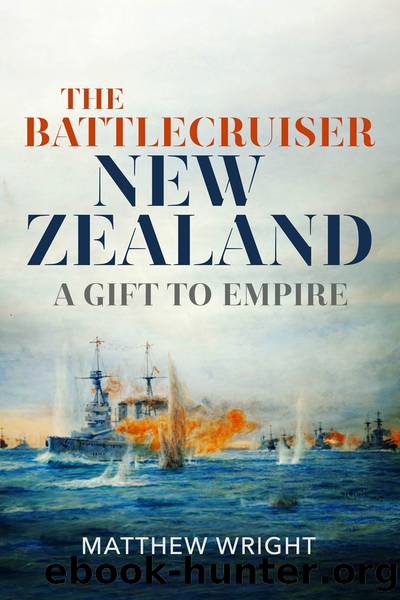The Battlecruiser New Zealand by Matthew Wright

Author:Matthew Wright
Language: eng
Format: epub
Tags: HISTORY / Military / Naval
Publisher: Pen and Sword
Published: 2021-08-30T00:00:00+00:00
CHAPTER 6
JUTLAND
It was miles more exciting than the other shows and we had a pretty hot time as we had to take on not only their battlecruisers, but about a dozen of their leading battleships and in addition to that they had a most terrific advantage of light â¦
Sub-Lieutenant Mick Barcroft to Bell Irving, 15 June 1916.1
The Battle of Jutland was the only clash of the great fleets in the First World War, a hectic afternoon and evening on 31 Mayâ1 June 1916 whose human impact for both nations is still remembered by families who lost loved ones in the battle. As Peter Hart and Nigel Steel have pointed out, it produced casualties for the Royal Navy of similar scale to those of an army âpushâ on the Western Front, a point often forgotten by history.2 The majority of the 6,784 British officers and men killed during the battle were aboard the three battlecruisers and two armoured cruisers sunk with the loss of virtually all hands.3
New Zealand was nearly not in the battle at all, after an incident on 21 April. Pakenhamâs squadron sailed from Rosyth at 4am that day to support a cruiser and destroyer sweep into the Kattegat, enforcing the blockade. Soon afterwards word came that the High Seas Fleet was sailing. Beatty took the rest of the battlecruiser fleet to sea and rendezvoused with Pakenham. Jellicoe, meanwhile, put to sea with the Grand Fleet. By midafternoon the battlecruisers were north-west of Horns Reef and steaming in line abreast. At 3.35pm Beatty ordered the ships to begin zig-zagging. Just then they entered a bank of fog. Australia was sailing with a cruiser to port, and swung to starboard while keeping a watch for New Zealand, which had been in that direction. Visibility was so poor, however, that when the two vessels spotted each other at 3.42pm they had no room to manoeuvre and struck a glancing blow. Australia came off second best, her side torn open from frames 59 to 78 by the armour plates protecting New Zealandâs side abaft P-turret, while New Zealandâs port outer propeller tore into Australiaâs hull below Q-turret. This damaged the propeller and left New Zealand briefly uncontrollable. As a result, she swung across Australiaâs bows and was rammed.4
To collide twice in three minutes was embarrassing. But here, close to enemy waters, it was potentially lethal. Australia came to a stop to let damage control parties stem incoming water, but New Zealand was able to keep moving. Both ships returned to Rosyth without further incident, where New Zealand was docked for repairs. Australia, however, had to be sent first to Newcastle, then Devonport. Both ships were out of action for around five weeks. The incident had a curious sequel when it finally surfaced back in New Zealand: reports that New Zealand had rammed Australia were dismissed on the basis that the collision had been the other way around.5 Trans-Tasman rivalries died hard.
Both battlecruisers were still in dock on 24 April when word came that the High Seas Fleet was coming out.
Download
This site does not store any files on its server. We only index and link to content provided by other sites. Please contact the content providers to delete copyright contents if any and email us, we'll remove relevant links or contents immediately.
| Automotive | Engineering |
| Transportation |
Machine Learning at Scale with H2O by Gregory Keys | David Whiting(3668)
Never by Ken Follett(3550)
Urban Outlaw by Magnus Walker(3251)
OPNsense Beginner to Professional by Julio Cesar Bueno de Camargo(3197)
Sapiens and Homo Deus by Yuval Noah Harari(2858)
Will by Will Smith(2595)
A Short History of Nearly Everything by Bryson Bill(2515)
Hooked: A Dark, Contemporary Romance (Never After Series) by Emily McIntire(2428)
Rationality by Steven Pinker(2160)
Borders by unknow(2122)
Holy Bible (NIV) by Zondervan(2031)
The Becoming by Nora Roberts(1934)
The One Percenter Encyclopedia by Bill Hayes(1723)
Freedom by Sonny Barger(1719)
HBR's 10 Must Reads 2022 by Harvard Business Review(1704)
A Short History of War by Jeremy Black(1679)
Five Ways to Fall by K.A. Tucker(1638)
Girls Auto Clinic Glove Box Guide by Patrice Banks(1624)
Go Tell the Bees That I Am Gone by Diana Gabaldon(1603)
